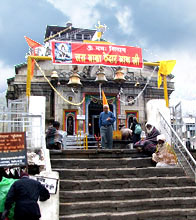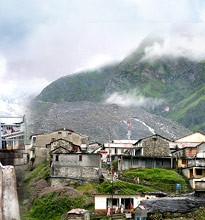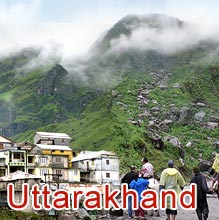 Uttarakhand is a region with great ethnic diversity. Though nobody can be called a native here, there are tribes and villages of people who have no other place to relate to. They are mostly dependent on agriculture and handicrafts. The economy revolves around the fairs that are held all round the year. Uttarakhand is divided into two major regions called Garhwal and Kumaon, on the basis of linguistic and geographic diversity. People of Uttarakhand are commonly known as Pahari, meaning people from hills.
Uttarakhand is a region with great ethnic diversity. Though nobody can be called a native here, there are tribes and villages of people who have no other place to relate to. They are mostly dependent on agriculture and handicrafts. The economy revolves around the fairs that are held all round the year. Uttarakhand is divided into two major regions called Garhwal and Kumaon, on the basis of linguistic and geographic diversity. People of Uttarakhand are commonly known as Pahari, meaning people from hills.Ethnicity
Uttarakhand has a number of tribes like Jadh, Marcha, Tolcha, Shauka, Buksha, Tharu, Jaunsari, Bhotia, Raji and Gujjar with ethnic Garhwali and Kumauni people. Anthropologically speaking Uttaranchal has living human samples from ancient races such as Proto-Australoid, Mongoloid, Nordic and Dravidian. There are about five groups of people who give a general idea of what Uttarakhand’s ethnicity is like:
Jaunsari
This group has a characteristic style of dressing and exclusive cultural observances. Jaunsari society is a collection of smaller tribes, hence is divided by ‘caste’ with the indigenous Koltas and Khasas. The Jaunsari group is identified to be one of the rare polyandrous societies in the world.
Bhotia
The Bhotias conventionally live in the high altitudes of the Himalayas and are separated into many sub-groups, specifically the Jadh, the Marcha and the Shaukas. These three groups have diverse cultures but they have a common Tibetan-Mongoloid like physical appearance.
Buksha
Buksha are the residents of the Terai district of Uttarakhand and they assert their lineage from the Rajputs. The culture of the Buksha reflects a typical Hindu society but they also accept the existence of nature spirits and eat meat.
Tharu
The Tharu are tribals from the eastern region of Terai. They trace their ancestry to the original migrant Tibetan tribes. The Tharus live in large families under one-roof like joint families. A distinctive characteristic of the Tharu culture is that their society has a Matriarchal nature.
Raji
Raji are known as Vanrawats and they dwell in the forests around Ascot in southern Pithoragarh. The Rajis also boast of a Matriarchal culture with women as the head of their society. They used to practice shifting agriculture but the forest rules and regulations have made them transfer to making wooden utensils to trade for other commodities.










